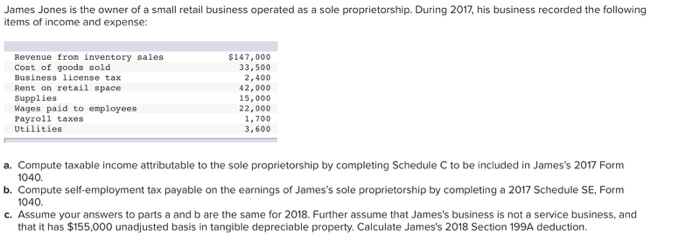James Jones is the owner of a small retail business operated as a sole proprietorship. During 2017, his business recorded the following items of income and expense: Revenue from inventory sales Cost of goods sold Business lieense tax Rent on retail space Supplies Mages paid to employees Payroll taxes Utilities $147,000 33, 500 2,400 42,000 15,000 22,000 1,700 3,600 a. Compute taxable income attributable to the sole proprietorship by completing Schedule C to be included in James's 2017 Form 1040. b. Compute self-employment tax payable on the earnings of James's sole proprietorship by completing a 2017 Schedule SE, Form 1040.
James Jones is the owner of a small retail business operated as a sole proprietorship. During 2017, his business recorded the following items of income and expense: Revenue from inventory sales Cost of goods sold Business lieense tax Rent on retail space Supplies Mages paid to employees Payroll taxes Utilities $147,000 33, 500 2,400 42,000 15,000 22,000 1,700 3,600 a. Compute taxable income attributable to the sole proprietorship by completing Schedule C to be included in James's 2017 Form 1040. b. Compute self-employment tax payable on the earnings of James's sole proprietorship by completing a 2017 Schedule SE, Form 1040.
Chapter16: Accounting Periods And Methods
Section: Chapter Questions
Problem 33P
Related questions
Question

Transcribed Image Text:James Jones is the owner of a small retail business operated as a sole proprietorship. During 2017, his business recorded the following
items of income and expense:
Revenue from inventory sales
Cost of goods sold
Business license tax
$147,000
Rent on retail space
Supplies
Wages paid to employees
Payroll taxes
Utilities
33,500
2,400
42,000
15,000
22,000
1,700
3,600
a. Compute taxable income attributable to the sole proprietorship by completing Schedule C to be included in James's 2017 Form
1040.
b. Compute self-employment tax payable on the earnings of James's sole proprietorship by completing a 2017 Schedule SE, Form
1040.
c. Assume your answers to parts a and b are the same for 2018. Further assume that James's business is not a service business, and
that it has $155,000 unadjusted basis in tangible depreciable property. Calculate James's 2018 Section 199A deduction.
Expert Solution
This question has been solved!
Explore an expertly crafted, step-by-step solution for a thorough understanding of key concepts.
This is a popular solution!
Trending now
This is a popular solution!
Step by step
Solved in 3 steps

Knowledge Booster
Learn more about
Need a deep-dive on the concept behind this application? Look no further. Learn more about this topic, accounting and related others by exploring similar questions and additional content below.Recommended textbooks for you


Intermediate Accounting: Reporting And Analysis
Accounting
ISBN:
9781337788281
Author:
James M. Wahlen, Jefferson P. Jones, Donald Pagach
Publisher:
Cengage Learning



Intermediate Accounting: Reporting And Analysis
Accounting
ISBN:
9781337788281
Author:
James M. Wahlen, Jefferson P. Jones, Donald Pagach
Publisher:
Cengage Learning
